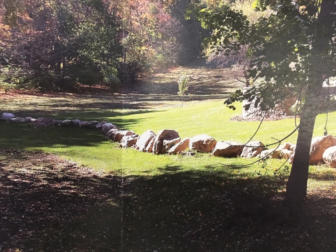Citing multiple violations of regulations designed to protect some of New Canaan’s most fragile natural resources, town officials have levied a $1,000 fine against a White Oak Shade Road homeowner.

A view of the area at 139 White Oak Shade Road where wetlands violations have occurred. Inland Wetlands photo
According to a citation that is scheduled for discussion at Monday’s meeting of the Inland Wetlands Commission, municipal workers visiting the 1-acre property at 139 White Oak Shade Road last month “viewed a significant amount of earth disturbing activities in and over wetlands and in the onsite pond that is currently dry without standing water.”
Specifically, a wetlands area of about 3,000 square feet was stripped of its vegetation, with underlying soils disturbed by filling, raking and grading, and seed and mulch mix deposited into it, according to the citation and Notice of Violation, issued Oct. 18 by staffers in the Inland Wetlands Department.
Additionally, an upland review area of about 3,200 square feet was altered “by seeding and maintaining a lawn,” the citation said.
“These activities have disturbed the underlying wetlands and watercourse that are protected under the Regulations,” it said. “No soil and erosion controls were installed.”
The property—formerly a vacant lot, recognizable to many New Canaanites as the bottom of the sledding hill that runs up alongside Putnam off of White Oak Shade—was purchased for $850,000 in late-2013. The following summer, a new 3,550-square-foot home was built on the parcel.
A soil scientist’s report from 2012 that shows a March 2014 date stamp from the Inland Wetlands Department—about four months before the home was built—identifies and delineates the wetlands on the property.
Under the New Canaan Inland Wetlands and Watercourses Regulations, activities such as filling, excavation, dredging, clear cutting and grading wetlands and watercourses require a permit.
The White Oak Shade homeowner by moving forward, unpermitted, with what appears to be a pond-filling operation—and it doesn’t matter whether the pond is natural or manmade, under the regulations—was found to be in violation of Section 5.4 (see page 14 here).
The commission (see Section 7, starting on page 16) also oversees non-wetland or non-watercourse areas likely to affect wetlands or watercourses—called “upland review areas.” As such, certain activities in upland review areas—such as clearing, grubbing, filling, grading, paving, excavating, constructing, depositing or removing of material and discharging of stormwater—also are regulated and require permits.
According to the citation, wetlands officials inspected the property “in response to reported observations from the land use inspector regarding possible regulated activities at this location.”

Wetlands are areas where water covers soil all or part of the time. These regulations may appear unduly restrictive, but wetlands are important because they protect and improve water quality, provide fish and wildlife habitats, store floodwaters, and maintain surface water flow during dry periods. The regulations exist because we can’t rely on individuals to protect them for all of us.